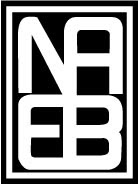Actually there's a lot of acronyms today so I just picked one with a good vowel to  consonant ratio. The story has 4 stages.
consonant ratio. The story has 4 stages.
 consonant ratio. The story has 4 stages.
consonant ratio. The story has 4 stages. 1. ACUBS
2. NAEB
3. NERN
4. NPR
By the mid twenties the idea of using radio to enhance the school curriculum was getting popular. ACUBS (the Association of College and University Broadcasting Stations) began in 1925 kind of loosely to promote that idea. It was they who got the non-com band sanctioned.
It became the National Association of Educational Broadcasts Tape Network (NAEB) in 1934 as an informal association of managers of university radio stations.
Their Tape Network was a way to exchange taped programming among it's member stations. They distributed programs produced by one member station to other syndicating members. This was done with actual reel-to-reel tapes. (By the early fifties transcription discs were already on the way out. ) For example, WFBE in Flint, MI produced a program called "The Old Record Box," a short 15-minute program playing primarily cylinder recordings from the early 1900s. WBOE and a number of other educational broadcasters carried the program. In 1967 they distributed 1,895 programs to its 150 affiliate stations, a total of 31,371 hours of programming.
In 1967 NAEB surveyed a study of it's 320 member stations. They actually just sent out questionnaires. Only 135 stations, responded but they determined from the responses about staffing, budgets and so forth that these statiosn were "limited by low budgets, small staffs, and a lack of both audience research and program promotion." Oh how thing have changed... The survey also determined that the average educational brodcaster has an annual budget of under $25,000.
In 1963 The NAEB Tape Network became the National Educational Radio Network (NERN.) NERN's own budget was about 60k and they were self sufficient on member fees. But NERN wasnt' the only distributor of educational programming. Broadcasting Foundation of America, the Eastern Educational Radio Network and the Intercollegiate Broadcasting System all were doing similar things. The competing distributors also competed for membership dollars. It's no susprise then that the Carnegie Commission would start head shaking.  The Carnegie Commission then issued that fundamental 1967 "Report on the Future of Public Broadcasting." It recommended the creation of everythign we have in public radioland today: PBS, NPR and the CPB. In 1970 ownership of NERN is transferred to NPR. NPR continued to distribute programs moving over to 5 kHz land line system for talk programs in 1980. Then in the 1980s, NPR was the first U.S. radio network to move to satellite distribution.
The Carnegie Commission then issued that fundamental 1967 "Report on the Future of Public Broadcasting." It recommended the creation of everythign we have in public radioland today: PBS, NPR and the CPB. In 1970 ownership of NERN is transferred to NPR. NPR continued to distribute programs moving over to 5 kHz land line system for talk programs in 1980. Then in the 1980s, NPR was the first U.S. radio network to move to satellite distribution.
 The Carnegie Commission then issued that fundamental 1967 "Report on the Future of Public Broadcasting." It recommended the creation of everythign we have in public radioland today: PBS, NPR and the CPB. In 1970 ownership of NERN is transferred to NPR. NPR continued to distribute programs moving over to 5 kHz land line system for talk programs in 1980. Then in the 1980s, NPR was the first U.S. radio network to move to satellite distribution.
The Carnegie Commission then issued that fundamental 1967 "Report on the Future of Public Broadcasting." It recommended the creation of everythign we have in public radioland today: PBS, NPR and the CPB. In 1970 ownership of NERN is transferred to NPR. NPR continued to distribute programs moving over to 5 kHz land line system for talk programs in 1980. Then in the 1980s, NPR was the first U.S. radio network to move to satellite distribution. 



No comments:
Post a Comment